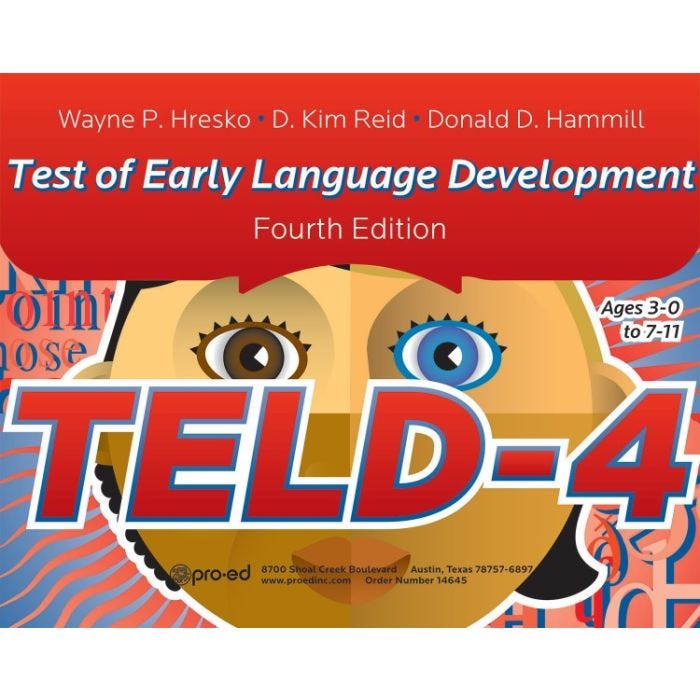TELD-4: Test of Early Language Development - Fourth Edition

| ITEM# | PRODUCT NAME | AVAILABILITY | PRICE | QTY/ACTIONS |
|---|---|---|---|---|
| 74133 |
TELD-4 Complete Kit
Excluded from Shipping Discount |
In Stock |
$514.99
|
|
| 1008164 | TELD-4 Examiner Record Booklet Form A, 25/Pkg |
Ships Soon |
$92.99
|
|
| 1008165 | TELD-4 Examiner Record Booklet Form B, 25/Pkg |
In Stock |
$92.99
|
Product Description
Ages: 3-0 through 7-11
Testing Time: 15 to 45 minutes
Administration: Individual
The test uses brief, simple tasks to assess the broad picture of a child's language development, specifically the areas of semantics, syntax, and morphology. It is used to identify language delays (compared to age-related peers), to determine a child's strengths and weaknesses in the above language areas, to track a child's progress within a remediation program, or for research studies.
Users now have access to the new optional PC-, Mac-, Chromebook-, and tablet-compatible TELD-4 Online Scoring and Report System via activation codes that are included in each package of Examiner Record Booklets. This system is a quick, efficient tool for (a) entering test session data; (b) converting subtest item scores or total raw scores into scaled scores; (c) generating composite index scores, percentile ranks, and upper and lower confidence intervals; (d) comparing TELD-4 scores to identify significant intraindividual differences; and (e) obtaining a score summary or narrative report. Use of the software ensures accurate application of basals and ceilings and calculation of scores.
TELD-4’s psychometric qualities:
Demographics: Standardized on a representative sample of 1,074 children representing 32 states and 292 different zip codes.
Reliability: Extensive studies of test reliability (coefficient alpha, test-retest, immediate and delayed alternate forms, and interscorer) support the use of the TELD-4 with individual students. Average coefficient alphas for the full normative sample range from .95 to .97 for subtests and the composite.
Validity: Content-description validity was established through careful selection of items, controlled vocabulary, construct review by a panel of language experts, conventional item analysis, as well as analysis of the test floors, ceilings, and item gradients, and differential item functioning.
Criterion-prediction validity was established by
(a) correlating TELD-4 standard scores with commercially available measures of reading ability (i.e., PLS-5, TACL-4, and TEXL)
(b) comparing means and standard deviations between the TELD-4 and criterion tests
(c) computing sensitivity, specificity, and ROC/AUC statistic.
Construct-identification validity was established by studying
(a) the relationship of the TELD-4 standardized scores with age, academic achievement, and intelligence
(b) the ability of the test’s standard scores to differentiate groups with known language problems from those without such problems
(c) the factorial fit of the subtests to the construct in the test model (i.e., spoken language).
Limiting bias: Was examined using differential item functioning techniques. Further, a wide range of both mainstream and minority populations, including gender, racial, ethnic, linguistic, and disability categories, was included in the normative sample. Finally, reliability and validity information is provided for different mainstream and minority subgroups.
Complete kit includes: Examiner’s Manual, Picture Book, 25 Examiner Record Booklets Form A, and 25 Examiner Record Booklets Form B, in a sturdy storage box.
Specifications
| Assembly Required | No |
|---|
Reviews
Warnings
| Choking Hazard | No |
|---|---|
| Sterile | No |